Does your marketing work?
That might seem like a simple question, but the answer is fairly complex—and it’s only getting harder to tackle.
The key, of course, is in your measurement. But new data challenges seem to crop up everyday, from privacy-related data deprecation to limitations inherent in multi-touch attribution models.
Understanding the impact your marketing is actually having on your business will likely take some work. That starts with assessing how mature your measurement strategy is so you can figure out exactly what you need to do to get there.
But have no fear: we’ve got the tools you need to get you there.
The different stages of marketing measurement maturity
To help you assess how effectively your brand is measuring that impact, we’ve put together a helpful friendly pyramid outlining what it takes to make the climb to full maturity.
The very bottom level is focused on the bare minimum of measurement capabilities: baseline single channel measurement, where you’re tracking the performance of each channel on its own, often in the platform itself.
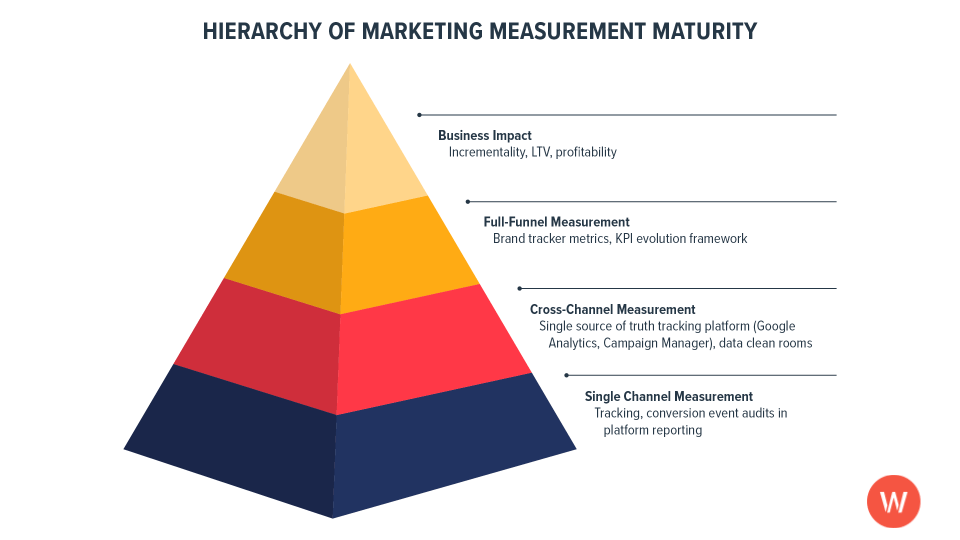
Cross-channel measurement is where marketers implement a tracking platform like Google Analytics that can act as a single source of truth. They can then get a better sense of how channels are working together and get closer to understanding overall performance.
Once you’ve mastered basic cross-channel, your brand can progress to full-funnel measurement, where the difficulty level suddenly spikes. The further away a touchpoint is from the conversion point, the harder it is to track. But if you want your measurement to accurately reflect the full impact marketing is having, it’s essential to incorporate upper- and mid-funnel channels and media activations into your framework.
Finally, after that long slog upward, you’ve reached the very top, where you’ll find the tools that will help you understand and articulate true business impact. The bonus? Everything else gets more accurate because you have a more complete picture of the overall outcomes.
The first stage of marketing measurement maturity: single channel measurement
Measuring a single channel is where it all starts; the simplest version is in-platform tracking of conversions the channel is driving, but keep in mind it can’t really provide the full picture when it comes to attribution because it’s limited to the view of one channel.
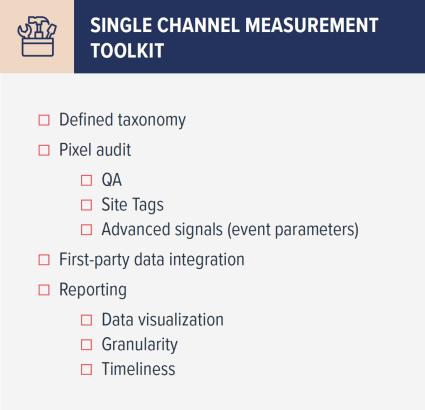
Even single channel measurement has to be set up correctly to work. In particular, you need clean tracking in place to ensure you’re feeding accurate and comprehensive data back into your platforms for optimization.
Audit your platform pixel and site tags to make sure you’re correctly capturing conversions as well as any relevant parameters associated with the conversion event. If you’ve made a sale, for example, you probably want to capture revenue. But that’s not sufficient: you also need to track other important fields like location or customer ID to match against your data so you can understand whether it was a new or return sale or whether a promo code was used.
As signal quality declines due to in-browser and in-app tracking mitigations like Apple’s AppTrackingTransparency (ATT), you need to focus on resilient data portability methods to feed the advertising platform algorithms. You can still track total conversion volume in the face of data loss by leveraging server-side data capture (like Facebook CAPI and Google Enhanced Conversions).
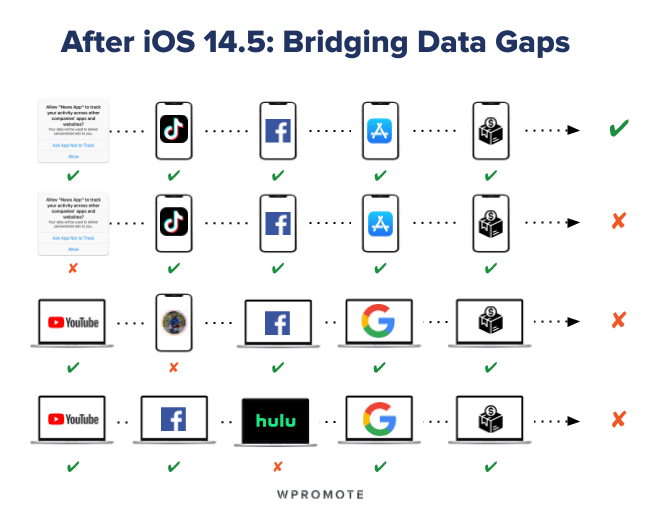
You cannot match all of the conversion events back to their upstream media touchpoints, so you need to use first-party data to match based on an identity attribution (name, email address, phone number, IP address) and bridge additional gaps in conversion tracking.
Brands frequently get single channel wrong if they don’t recognize its limitations. Without a holistic view of the entire customer journey across channels, it’s impossible to get the full picture of performance and you’re much more likely to assign duplicate credit for conversions.
The second stage of marketing measurement maturity: cross-channel measurement
Integrated cross-channel measurement solves some of those problems. It usually requires a combination of analytics tools and techniques, including web analytics, customer relationship management (CRM) systems, customer data platforms (CDPs), data clean rooms, and data management platforms (DMPs).
Cross-channel measurement will give you a more holistic view of how your media mix is working as a whole and a clearer picture of how channels are impacting each other and how customers are moving through the funnel prior to conversion.
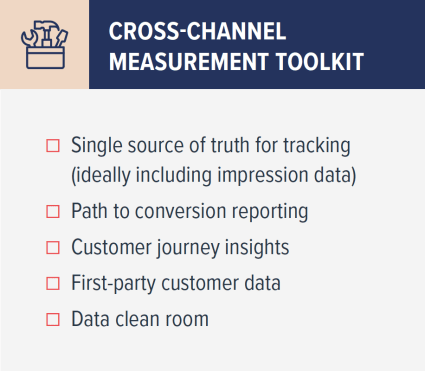
That generates insights that can give your media strategy a leg up. If you know one channel is helping to drive users to convert to another channel, for example, you’ll have a better idea of where to put your budget to achieve your objectives.
In the end, cross-channel insights help marketers optimize their marketing spend, improve customer experiences, and drive better business outcomes. But you need to have the right toolkit in place.
Deterministic data sets are the gold standard for cross-channel measurement because you can observe the customer journey and media overlap directly to understand how channels holistically drive acquisition.
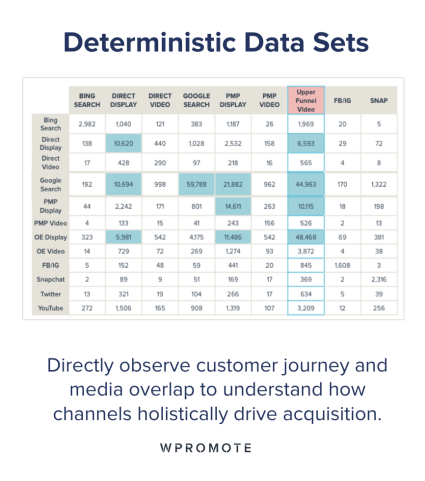
But the realities of modern data restrictions and the rise of walled gardens have made deterministic data much harder to get. That’s when you should turn to a probabilistic approach to understand channel impact through cross-correlation and modeled channel spend.

With so much data loss in recent years, many brands have reverted back to a statistical or modeled approach to measurement and media optimization favoring probabilistic measurement over deterministic tracking.
Martech infrastructure is critical to this approach. It needs to meet the needs of your campaigns and activated marketing channels as well as act as the single source of truth for tracking and conversion attribution. Ideally, your tech solution includes impression and view-through conversion tracking, which are necessary to effectively expand into mid- and upper-funnel measurement.
The third stage of marketing measurement maturity: full-funnel measurement
Understanding and quantifying the value of upper funnel brand campaigns on lower funnel conversions is one of the most challenging measurement initiatives for any brand. But it’s absolutely mission critical for your business’s long-term health and viability.
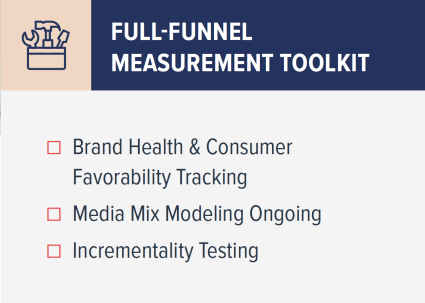
You need to look beyond conversion values to understand how the upper funnel is contributing to your goals.
It starts with brand measurement. Leverage surveys tracking brand health and consumer favorability to understand growth in brand awareness and favorability over time.
But that’s not enough, because you don’t just need to know brand campaigns are working in the upper funnel, you need to know how they’re affecting the lower funnel. There are two primary tools we use to make that connection: incrementality testing and media mix modeling (MMM).
Incrementality testing helps you understand the actual impact your ads are having by removing conversions that would have happened anyway, so it’s especially useful for brand measurement.
You can leverage a matched market test to understand the incremental lift in brand health metrics (i.e. awareness, consideration, favorability) driven by brand media and the subsequent incremental observed conversion volume lift. Make sure you’re allowing for enough time in those tests so any effects will actually show up.
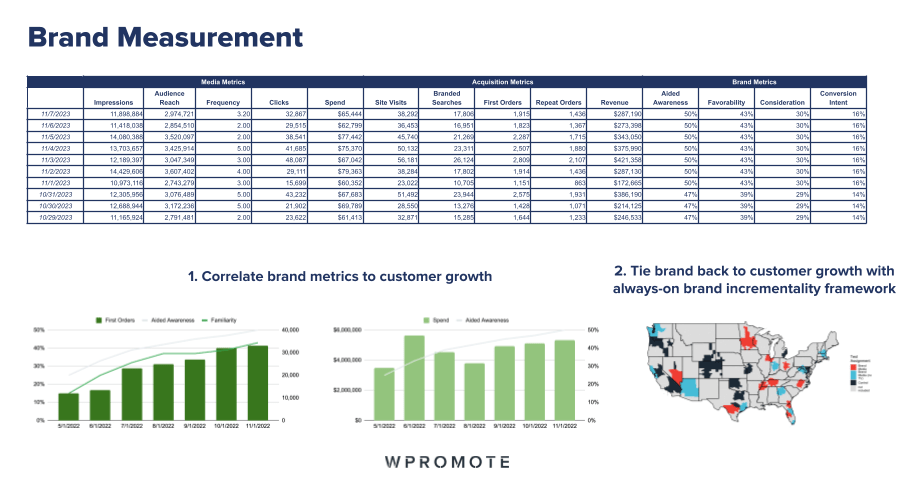
MMM is a holistic measurement approach used to determine cross-channel lift driven across all marketing efforts, informing media mix optimization and budget forecasting.
Your MMM should include brand metrics (aided awareness, for example) as inputs into the model structure so you can quantify the impact of brand performance on subsequent conversion volume. Keep in mind that you’ll need a large volume of brand health metrics stored consistently over time to develop the model itself.
MMMs come with their own challenges: they can be expensive and they’re traditionally very slow. But there is a new class of MMMs that are characterized as high velocity, like Wpromote’s Growth Planner.
These upgraded MMMs are built to accurately predict outcomes and measure channel contribution to historical conversions without utilizing individual data, significantly speeding up the process.
The final stage of marketing measurement maturity: understanding business impact
To reach the final stage of marketing maturity and finally answer the question of whether your marketing is working or not, you need to deploy some additional tools and incorporate incrementality testing into your regularly scheduled programming.
We already talked about incrementality testing to understand upper funnel impact, but that’s not the only value it brings to the table. It can also help you:
- Understand the true lift in key KPIs and business results driven by marketing efforts
- Determine a “next best dollar spent” by understanding the relative lift across platforms, tactics, and audiences
- Calibrate forecasting and budgeting models to true causality
- Understand insights into media effectiveness over time and at various spend thresholds
The insights you get out of incrementality testing will help you answer some critical strategic questions, including:
- What is the impact of one channel compared to another?
- How many new customers will I gain if I spend more? How many will l lose if I spend less?
- What is the value of adding a new channel into the media mix?
- How many additional customers do I gain by running a promotion?
Start by choosing a test design. Your decision will be largely dependent on whether the test is targeting known (first-party) or unknown audiences (third-party) and whether it is platform-specific or cross-platform. Matched market geo-testing is often the default test for cross-channel testing or offline (non-trackable) media because it’s the only way to get a consistent view across platforms.
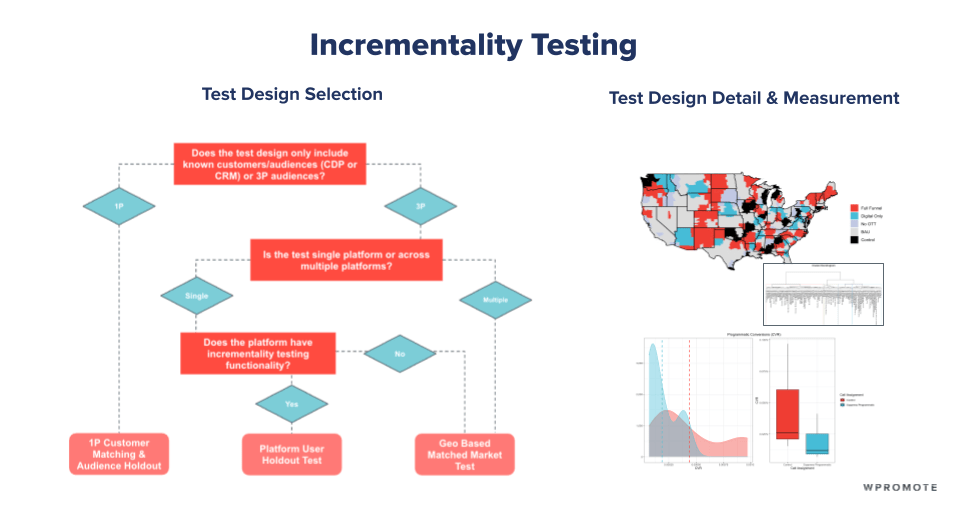
Other types of incrementality testing include user-based audience holdout, which measures the continuous incrementality of a single channel, and first-party audience holdout, which tests the efficacy of retention efforts to drive repeat purchases.
Once you’ve chosen a test design, you need to work out the details, including different variable assignments, defined sample sizes, budget, and timelines, then measure the results once it’s deployed, including a mid-point analysis to determine if you should stop the test early.
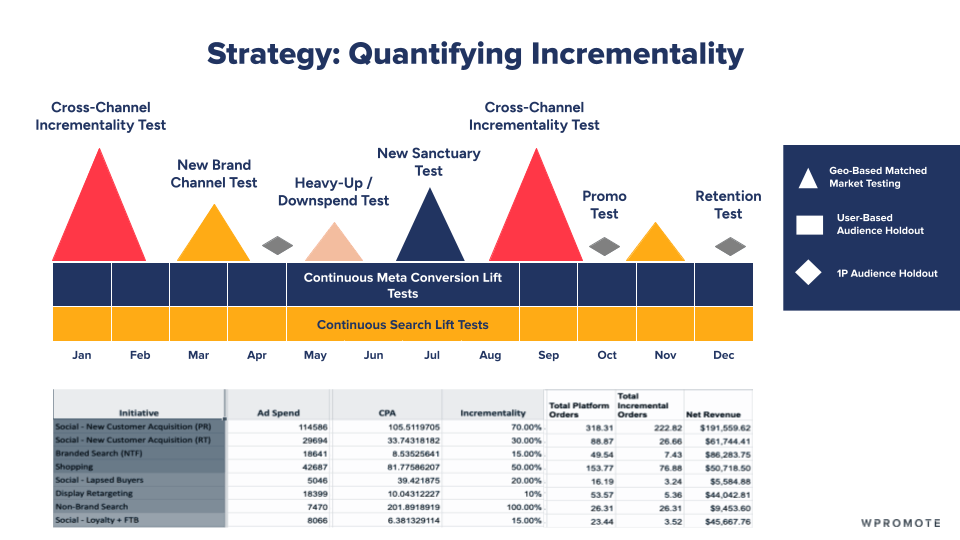 Different types of incrementality tests should be flighted at different points across the year to get the full picture of marketing impact. Once each test is over, you’ll need to report the results to all stakeholders and leverage those results to inform and improve your models.
Different types of incrementality tests should be flighted at different points across the year to get the full picture of marketing impact. Once each test is over, you’ll need to report the results to all stakeholders and leverage those results to inform and improve your models.
The critical questions your marketing measurement needs to be able to answer
We started with the big kahuna of marketing questions: is it working? Once you’ve reached the final stage of marketing maturity, you can start to get more specific with your questions:
- Am I making more money than I’m spending?
- How much does it cost to acquire a new customer?
- How much money am I making per customer?
- Is my marketing contributing to overall business growth?
From there, you’ll be able to drill down into the efficacy of your media investment to generate some truly actionable insights. That’s where some follow-up questions come into play:
- What channels, creative assets, and audiences should I invest in to grow efficiently?
- Are efficient media tactics driving business impact (incrementally)?
- How do I know how much and when to spend across each tactic?
- What tactics help us acquire higher-quality customers that lead to profitability?
Measurement will be a critical differentiator for brands in the future. Make sure your business is positioned to win against the competition with a strong measurement strategy that ladders up into business impact.







Responses